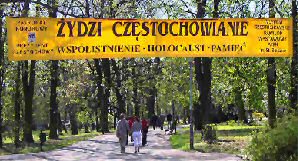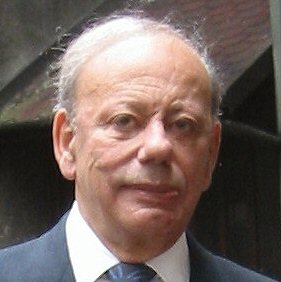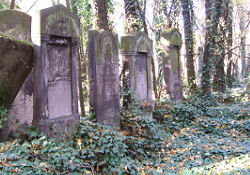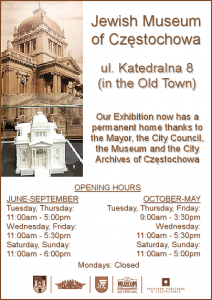How It Began
"The Jews of Częstochowa - Coexistence, Holocaust, Memory"
How It Began
 Following its opening during our First World Society Reunion in April 2004 in Częstochowa, the Exhibition went on show in Poland’s capital, Warsaw in the following October. A travelling version of the Exhibition subsequently visited cities in the United States of America and in Canada.
Following its opening during our First World Society Reunion in April 2004 in Częstochowa, the Exhibition went on show in Poland’s capital, Warsaw in the following October. A travelling version of the Exhibition subsequently visited cities in the United States of America and in Canada.
The full exhibition then temporarily went into storage until it found a permanent home in the Jewish Museum of Częstochowa at ul. Katedralna 8.
The original idea of creating such an exhibition came from a granddaughter of Rabbi Nachum Asz (a leader of the Jewish community of Częstochowa in the early 1900’s), Professor Elizabeth Mundlak, who had for years been active in the Polish Association of the Children of the Holocaust. Her idea was supported by Prof. Dr. hab. Jerzy Mizgalski, a historian and a former Vice-Chancellor of the Jan Długosz University of Częstochowa.
 The Exhibition traces the history of Częstochowa’s Jewish community, from the beginning of the nineteenth century, through the tragic years of WWII, to the post-War period. The many photographs and precious objects come from state and private collections, both from Poland and abroad.
The Exhibition traces the history of Częstochowa’s Jewish community, from the beginning of the nineteenth century, through the tragic years of WWII, to the post-War period. The many photographs and precious objects come from state and private collections, both from Poland and abroad.
Numerous photographs are reprints from Czenstochower Yidn published in New York in 1947. The Exhibition includes documentary films based on the memories of Holocaust survivors Sigmund A Rolat and Elizabeth Mundlak, as well as many others.
Funded by Sigmund Rolat and Alan Silberstein, the Exhibition was put together utilising the resources of the Pedagogical Institute of Częstochowa, the Częstochowa Municipal Archives and the Jewish Historical Institute in Warsaw.
From the Exhibition’s Sponsor, Sigmund A. Rolat ….
 I was a Pole whose religion happened to be Jewish. And then came the rude awakening. During the War, the Germans declared Jews to be “Untermenschen” and our Polish compatriots, with some notable exceptions, were passive or worse.
I was a Pole whose religion happened to be Jewish. And then came the rude awakening. During the War, the Germans declared Jews to be “Untermenschen” and our Polish compatriots, with some notable exceptions, were passive or worse.
The horrors continued after the War. In 1946, there was the Kielce pogrom and random violence in other places. In 1968 – the coup de grace – Poland lost her Jews as a result of the communist government’s so-called “Anti-Zionist Campaign”.
I was lucky to have immigrated to the USA where I proved, as millions before and after me have done, what America is all about. A young, penniless, orphaned boy, willing to apply himself, can receive the best education, prosper in business and secure a solid place in society for his family. Only in America!
But my roots are here, I am a Jew from Częstochowa. I wish my city well. May it prosper and grow.
I salute all those wonderful people who turned a wish into a reality starting with Prof.Berdowski, Prof.Mizgalski and former City Mayor Tadeusz Wrona.
I am grateful to Elizabeth Mundlak Asch, Elżbieta Surma-Jończyk, Janusz Jadczyk, Jan Jagielski, Ireneusz Kozera, Prof.Jarosław Kweclich, Prof.Tadeusz Panecki, Mark Shraberman, Dr.Dove B.Schmorak and especially to my dear Piotr Stasiak for their untiring work and countless hours. My cousin, Alan Silberstein, and I are proud to be part of this distinguished team.
I trust that all who view the Exhibition, and the book that depicts its exhibits, old and young – especially the young – will shed a tear for the once-vibrant community that is now reduced to a tiny handful.
Our Exhibition
Our Exhibition
The first volume of a biographical guide to the Jewish Cemetery of Częstochowa has been published by the History of Częstochowa Documentation Centre of the Museum of Częstochowa.
 The book contains a register of identified tombstones, short footnotes about the deceased and detailed biographies of more notable people buried in this necropolis. War-graves have been specifically highlighted. The guide also contains information about graves where, today, tombstones no longer exist or where the engraving on existing tombstones has completely eroded.
The book contains a register of identified tombstones, short footnotes about the deceased and detailed biographies of more notable people buried in this necropolis. War-graves have been specifically highlighted. The guide also contains information about graves where, today, tombstones no longer exist or where the engraving on existing tombstones has completely eroded.
This book is the first attempt at such a study. The authors have used both library and archival sources. They have collected data from both Polish and Jewish periodicals as well as works in Polish, German and Yiddish.
They also took advantage of a Polish inventory carried out in 1970-1975. At that time, every gravestone received its own number, however that inventory only listed the Polish-language inscriptions. In 1997, coordinated by Benjamin Yaari, a group of young Israelis, together with Martyna Strachel, Ada Holzman, Uri ben Zion and Michael Chen, listed over 2,000 monuments. Unfortunately, this work was incomplete, contained many errors and inaccurately recorded many names and dates. The authors of this guide have also utilised the results of both inventories.
Due to time constraints and the difficult or impossible access to many graves, the authors’ research within the cemetery itself has been limited. It did allow them, however, to correct and supplement the existing inventories.
This is the first attempt at work on this topic, because published material is limited and, not infrequently, in a “raw” state. The guide will, however, be continued in the form of a second edition or even a second part – depending upon how it is received by its readers and upon whether there is a demand for further work.
For this reason, we are asking for information to be sent to us about people buried in the Jewish Cemetery of Częstochowa, as well as photographs of both the people and also of their tombstones (if available). We also request information about the history of the cemetery itself.
| Our Address: Muzeum Częstochowskie Ośrodek Dokumentacji Dzieów Częstochowy, al. NMP 45a 42-200 Częstochowaemail: oddc@o2.pl |
The Authors:
Dr.Julius Sętkowski is an historian, having studied the 1905 Revolution. He is the author of monographs about the fighting-organizations of the Polish Socialist Party in the Częstochowa district and is also the author of two guides on the Częstochowa Catholic Cemeteries on Kula Street (including the sections of other faiths contained therein and the Evangelical Church section in Roch Street). He works at the Museum of Częstochowa, is Director of the History of Częstochowa Documentation Centre and heads the editorial team which is prepared the expansive “Encyclopaedia of Częstochowa”.
Wiesław Paszkowski was on the team to that prepared both the album “The Jews of Częstochowa – Coexistence, Holocaust, Memory” and the exhibition “The Jews of Częstochowa”. He is the author of articles on the history of Jewish education in Poland and on the state of research into the extermination of Częstochowa Jews. He works at the Museum of Częstochowa.
Our Exhibition
Our Exhibition
"The Jews of Częstochowa - Coexistence, Holocaust, Memory"
 This section of our website tells the story of our exhibition which, after travelling around the world, finally in 2016, found a permanent home in the Jewish Museum of Częstochowa – thanks to the Częstochowa Mayor and City Council. More information about the Jewish Museum can be found here HERE.
This section of our website tells the story of our exhibition which, after travelling around the world, finally in 2016, found a permanent home in the Jewish Museum of Częstochowa – thanks to the Częstochowa Mayor and City Council. More information about the Jewish Museum can be found here HERE.
Unlike many exhibitions about the history of Jews in Poland, our exhibition, while of course covering the tragic period of Holocaust, places specific emphasis on how the Jews of Częstochowa lived, not just how and where they died. This is particularly important for two groups of visitors to the Museum:
- The descendants of the Jews of Częstochowa, who have read, seen and heard so much about how and where their ancestors perished, can now see how these ancestors of theirs lived and can also understand the contribution which they made to the city Częstochowa and also to Polish life.
- Polish young people, today, live in a country which is 90-95% mono-cultural. It is easy for them to think that it was always like this when, in fact, prior to World War II, Poland was probably the most multi-cultural country in the whole of Europe. They need to learn and understand that among this ethnic mixture, Jews in Poland made up 10% of the total population and, in Częstochowa, 30% of its inhabitants were Jews.
This section covers how the exhibition came to fruition. It features the people who made it a reality through vision and determined effort. It also shows how the exhibition travelled the world before it finally found its permanent home in Częstochowa.
This exhibition is one major legacy which we can leave to our future generations. It is almost a self-evident truth that to understand who you really are, you need to understand where you come from. Through the exhibition we commit to that truth and, in doing so, we preserve the history and memory of those who came before us and can no longer tell their own story.
